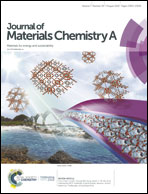A 3D Cu current collector with a biporous structure derived by a phase inversion tape casting method for stable Li metal anodes†
Abstract
Li metal has been considered to be the optimal anode material for the next generation high-density batteries due to its very high specific capacity and lowest electrochemical potential. However, various challenges, such as dendrite growth, volume change and low coulombic efficiency, have limited the practical applications of Li metal anodes. Herein, we report a 3D porous Cu current collector with a unique biporous and bicontinuous structure fabricated via a phase inversion tape casting method. It has two types of pores: “finger-like” pores, serving as microchannels for efficient electrolyte and Li ion diffusion, and random small pores, serving as “cages” to accommodate Li deposits. Moreover, the high areal current density can be dissipated remarkably because of the large surface area, resulting in a stable solid electrolyte interphase and dendrite-free anode. The as-prepared porous Cu current collector maintains stable performance and ultra-low voltage hysteresis for over 2000 h in symmetric cells and maintains a CE of 97.6% for 200 cycles in half cells. The porous Cu@Li//LiFePO4 full cells also present excellent cycling and rate performances. In addition, the phase inversion method is very suitable for mass production, indicating great potential for practical applications of Li metal anodes.



 Please wait while we load your content...
Please wait while we load your content...